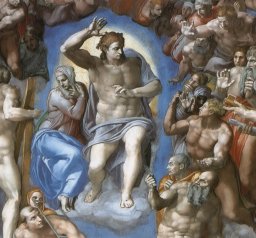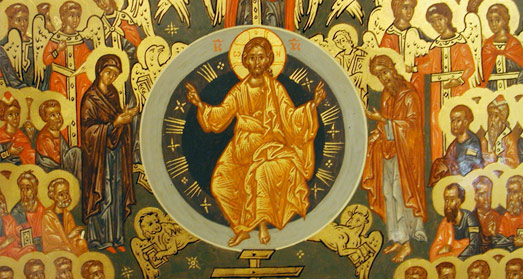The Rapture, the Antichrist, and the Second Coming of Christ – Pt. 2

As promised in my last post, we are now going to take a look at some of the main texts involved in presenting a biblical case for “the Rapture.” Over my next two posts, I will present seven of the most common and favorite go-to verses I used to use when I was a “Rapture” theorist before my conversion to Christ in his Church. The first is perhaps the most commonly used of all:
1. I Thess. 4:15-17:
For this we declare to you by the word of the Lord, that we who are alive, who are left until the coming of the Lord, shall not precede those who have fallen asleep. For the Lord himself will descend from heaven with a cry of command, with the archangel’s call, and with the sound of the trumpet of God. And the dead in Christ will rise first; then we who are alive, who are left, shall be caught up together with them in the clouds to meet the Lord in the air; and so we shall always be with the Lord.
The word “Rapture” actually comes from the Latin Vulgate “rapiemur,” translated here as “caught up” in verse 17. What’s the problem here? Does the “word of commandment of God, the voice of the archangel and the trumpet of God” sound like a “secret rapture?”
For those who did not read my last post, “the Rapture” represents a belief that has Jesus Christ snatching away all true Christians sometime in the near future in a “secret” event that will cause millions to simply disappear from the earth. In one sense it would not be a “secret” because the whole world will have to explain (or explain away) this massive disappearance of millions. But it will be “secret” in the sense that Jesus himself will not reveal it to the world for what it is.
The problem is, there is nothing “secret” about the coming of the Lord and this is precisely what this text is describing—the Second Coming of Christ at the end of time. Of course, St. Paul is describing the indescribable here using human terms. But notice, there is no 7-year tribulation mentioned—no 1,000 year millennium. Just as we Catholics would expect, St. Paul describes this event as the end of all things. “So shall we ever be with the Lord…” He does not say “so shall we be with the Lord for seven years and then we will come down to earth for 1,000 years…”
2. I Cor. 15:51-55:
Lo! I tell you a mystery. We shall not all sleep, but we shall all be changed {great text to place in crying rooms at Church!}, in a moment, in the twinkling of an eye, at the last trumpet. For the trumpet will sound, and the dead will be raised imperishable, and we shall be changed. For this perishable nature must put on the imperishable, and this mortal nature must put on immortality. When the perishable puts on the imperishable, and the mortal puts on immortality, then shall come to pass the saying that is written: “Death is swallowed up in victory.” “O death, where is thy victory? O death, where is thy sting?”
I can’t tell you how many sermons I heard (and preached!) on the Rapture that used this language of “in a moment, in the twinkling of an eye…”
Notice again the “trumpet of God?” This does not sound like a “secret rapture,” does it? And it does not sound like a preliminary coming of the Lord either! Just as with I Thess., this text indicates St. Paul is describing the end of the world. Notice in particular, “O death, where is thy victory? O death, where is thy sting.” In other words, death shall be no more at this point. And yet, according to Rapture theorists, death will just be beginning! They believe there will be millions if not billions killed during the tribulation and that death will continue even through the 1,000 year reign of Christ on earth. This text simply describes the Second Coming of Christ at the end of time. Period!
3. Matt. 24:32-34:
From the fig tree learn its lesson: as soon as its branch becomes tender and puts forth its leaves, you know that summer is near. So also, when you see all these things, you know that he is near, at the very gates. Truly, I say to you, this generation will not pass away till all these things take place.
The “fig tree” and “this generation” are the key words here. Rapture theorists connect this text to Matthew 21:19-20, where Jesus is reported as,
… seeing a fig tree by the wayside he went to it, and found nothing on it but leaves only. And he said to it, “May no fruit ever come from you again!” And the fig tree withered at once.
The idea here is that the “fig tree” represents Israel—or those in Israel who rejected the Messiah—being cursed by God because they rejected the Messiah. And we should note here that there is no doubt the fig tree does represent Israel that rejected Christ here in Matt. 21. Jesus had just the day before, in Matt. 21:12, driven out the money changers from the Temple. Then, immediately after he curses the fig tree, Jesus teaches several parables, all of which emphasize Israel being unfaithful to God and his Messiah resulting in God choosing to bless another “son” or “nation” who would believe and obey. We have the Parable of the Two Sons” in Matt. 21:28-32, the Parable of the Master of the Vineyard” in verses 33-46, and the Parable of the Marriage Feast in Matt. 22:1-14.
In fact, just so there could be no misunderstanding, Jesus gives us the interpretation of all of these parables when he plainly says in Matt. 21:43:
Therefore I tell you, the kingdom of God will be taken away from you [Israel that rejected Christ] and given to a nation producing the fruits of it.
So, there is no doubt that the “fig tree” represents Israel that rejected Christ in Matt. 21.
But the problem comes in when men like Hal Lindsey then say, when Jesus says in Matt. 24:30-32, “From the fig tree learn its lesson: as soon as its branch becomes tender and puts forth its leaves, you know that summer is near;” this means when Israel in the Middle East becomes a nation again, you know the end is near. In fact, Rapture theorists then claim that when Jesus says, “when you see all these things, you know that he is near, at the very gates. Truly, I say to you, this generation will not pass away till all these things take place,” he means “the generation” that sees Israel become a nation will see the coming of the Lord!
This is to stretch the context just a smidgeon, folks!
Men like Hal Lindsey have said that we are “this generation.” First, he said because Israel became a nation in 1948 (Matthew 24:34 fulfilled!), the end would come by 1988! Another famous radio preacher, the late Harold Camping, made similar claims, but he claimed the Rapture would happen in 1994, and twice in 2011!
At any rate, with regard to Hal Lindsay, he claimed if a generation is 40 years, and the “fig tree” generation was the generation that saw Israel become a nation… well… the conclusion is obvious! And you can find this in Hal Lindsay’s book: “The Late Great Planet Earth,” 1948 + 40 = 1988. Oops! By New Years of 1989, (or 1995, and 2012 for the Camping “camp”), all who followed his teaching had egg on their faces!
Some Rapture theorists revised their theory. I have heard some of them claim the end would come before 2007 because Jerusalem was recaptured in 1967; thus, all the land of Israel was not Israel’s until 1967. 1967 + 40 = 2007! Oops again! 2007 came and went! I heard Benny Hinn, a well-known TV Evangelist, a few years ago say on television a “generation” is actually 100 years, rather than the generally understood 40! How convenient! Now he has until 2048 or 2067!
At any rate, the context of Matt. 24:32-34 makes clear that Jesus was NOT referring to any re-establishment of Israel as a political entity. He is simply using a then-common way of knowing “summer is near,” that is, when the fig tree’s “branch becomes tender and puts forth its leaves.” In fact, in Luke’s version of this same saying of Jesus, he has Jesus saying, in Luke 21:29,
And he told them a parable: “Look at the fig tree, and all the trees…”
What would “all the trees” represent? Would that mean all the countries then existing would have to be reestablished as well? Of course not! Again, we do not deny that the fig tree is a symbol of Israel in Matt. 21:19. But we have a different context and usage of the fig tree in Matt. 24:32. Jesus is saying, “When you see these things know that things are ripe and ready.” Jesus is giving clues to believers of both the first century as well as the final generation, and all generations in between, as to what will be signs of covenant judgment coming on the earth.
Jesus is referring in the literal sense to the coming judgment of Israel through the destruction of the Temple in AD 70. But that judgment would be a type of the final fulfillment of all things at the end of time. He gives a number of clues as to what will be the signs of this coming judgment when he says, in essence, “just as you know summer is near when the fruits on the various trees begin to shoot, you will know that judgment is nigh when you see these things…”
This has nothing to do with Israel becoming a nation in 1948 or Jerusalem being captured in 1967!
Is Israel in the Middle East the “Israel” of Prophecy?
We are confining our thoughts here to “the Rapture” as much as we can, but whenever “Israel” comes up in a conversation with a Rapture theorist, there is a crucial point that you must be prepared for. Rapture theorists (more universally called “Dispensationalists”) teach that all of the promises concerning the land promised to the People of God in the Old Testament will be fulfilled in the millennial reign of Christ. They teach the Temple of the Old Covenant will be restored and some even teach that animal sacrifices will be re-instituted for the Jews! This betrays a faulty notion of what “Israel” represents in the New Testament.
Warning, Warning! Key point here:
All of the promises to the People of God in the Old Testament are fulfilled in Christ and the New Covenant Church he established, the Catholic Church.
The new Israel in the New Covenant is the Church, not the “Israel” that rejected and continues to reject Christ. In fact, St. Paul uses an allegory in Galatians 4:22-26 to make this point:
For it is written that Abraham had two sons, one by a slave and one by a free woman. But the son of the slave was born according to the flesh, the son of the free woman through promise. Now this is an allegory: these women are two covenants. One is from Mount Sinai, bearing children for slavery; she is Hagar. Now Hagar is Mount Sinai in Arabia; she corresponds to the present Jerusalem, for she is in slavery with her children. But the Jerusalem above is free, and she is our mother.
In Galatians 6:16, St. Paul plainly refers to the Church as the “Israel of God.”
Peace and mercy be upon all who walk by this rule, upon the Israel of God.
When Jesus prophesied the destruction of the Temple in Jerusalem as judgment permitted by God, he said, in effect, the only way to a relationship with God for the Jews is through recognizing their Messiah, Jesus Christ. In Matt. 23:36-24:2, and on the heels of Jesus declaring judgment was about to fall upon Israel for rejecting their Messiah, we read:
Truly, I say to you, all this will come upon this generation. O Jerusalem, Jerusalem, killing the prophets and stoning those who are sent to you! How often would I have gathered your children together as a hen gathers her brood under her wings, and you would not! Behold, your house is forsaken and desolate. For I tell you, you will not see me again, until you say, “Blessed is he who comes in the name of the Lord.” (ch. 24) Jesus left the temple and was going away, when his disciples came to point out to him the buildings of the temple. But he answered them, “You see all these, do you not? Truly, I say to you, there will not be left here one stone upon another that will not be thrown down.”
St. Paul uses unequivocal language concerning the Jews who rejected the Messiah in Romans 2:28-29:
For he is not a real Jew who is one outwardly, nor is true circumcision something external and physical. He is a Jew who is one inwardly, and real circumcision is a matter of the heart, spiritual and not literal.
Thus, the Church is the “New Israel.” This does not mean that God does not have a plan for those who are Jews, “according to the flesh,” as Scripture calls them. In fact, the CCC 674 tells us, referencing Romans 11:20-29, that:
The glorious Messiah’s coming is suspended at every moment of history until his recognition by “all Israel”, for “a hardening has come upon part of Israel” in their “unbelief” toward Jesus. St. Peter says to the Jews of Jerusalem after Pentecost: “Repent therefore, and turn again, that your sins may be blotted out, that times of refreshing may come from the presence of the Lord, and that he may send the Christ appointed for you, Jesus, whom heaven must receive until the time for establishing all that God spoke by the mouth of his holy prophets from of old.” St. Paul echoes him: “For if their rejection means the reconciliation of the world, what will their acceptance mean but life from the dead?” The “full inclusion” of the Jews in the Messiah’s salvation, in the wake of “the full number of the Gentiles”, will enable the People of God to achieve “the measure of the stature of the fullness of Christ”, in which “God may be all in all.”
There will be a large number of Jews, “according to the flesh”, come to Christ in the last days before the coming of the Lord, but this does not mean that all of the promises of God to the Jews are not fulfilled in the Church. They are. All people, whether Jew or Gentile must come to Christ in order to experience the sacraments, especially baptism, that have the effect of joining all of humanity as one in Christ where, as St. Paul says in Galatians 3:26-29:
For in Christ Jesus you are all sons of God, through faith. For as many of you as were baptized into Christ have put on Christ. There is neither Jew nor Greek, there is neither slave nor free, there is neither male nor female; for you are all one in Christ Jesus. And if you are Christ’s, then you are Abraham’s offspring, heirs according to promise.
4. No treatment on the Rapture is complete without addressing the famous “left behind” texts of, for example, Matt. 24:40-42:
Then two men will be in the field; one is taken and one is left. Two women will be grinding at the mill; one is taken and one is left. Watch therefore, for you do not know on what day your Lord is coming.
This is the text (along with the parallel texts in the other synoptic Gospels) where the famous “left behind” series of books (and now movies) by Tim Lahaye and Jerry Jenkins got their names. It is taken to mean that one day believers will be secretly “raptured” away and the rest will be “left behind.”
What’s the problem here, you ask?
First, if we read the three verses leading up to this text, we find this:
As were the days of Noah, so will be the coming of the Son of man. For as in those days before the flood they were eating and drinking, marrying and giving in marriage, until the day when Noah entered the ark, and they did not know until the flood came and swept them all away, so will be the coming of the Son of man.
It seems from the text that the folks who are being “taken away” are being “taken away” to judgment rather than to heaven. He says, “as in those days before the flood… they did not know until the flood came and swept them away.”
Secondly, and along these same lines, if we go to a parallel text to this one, in Luke 17:34-37, we find this:
I tell you, in that night there will be two in one bed; one will be taken and the other left. There will be two women grinding together; one will be taken and the other left. And they said to him, “Where, Lord?”
If you asked any dispensationalist today the question, “Where are those who are ‘taken away’ going?” They would respond, immediately, “To Heaven!” But what did Jesus say to the apostles when they asked him where they were going to be taken?
He said to them, “Where the body is, there the eagles [Gr. aetoi, vultures, eagles – the word is being used to convey birds of prey feasting on carcasses] will be gathered together.”
That doesn’t sound like heaven, does it?
If you liked this, and if you want to learn more, click here






